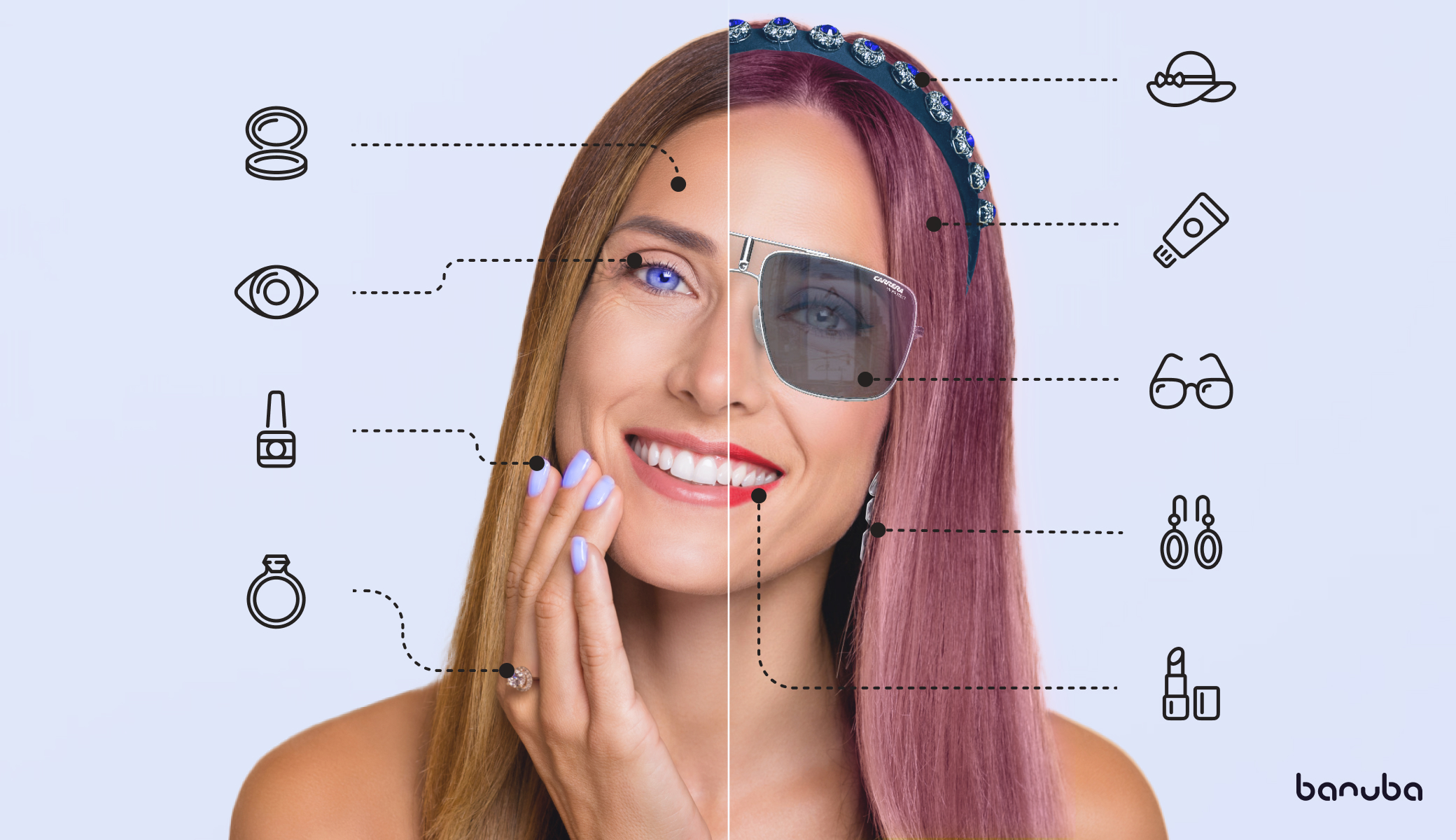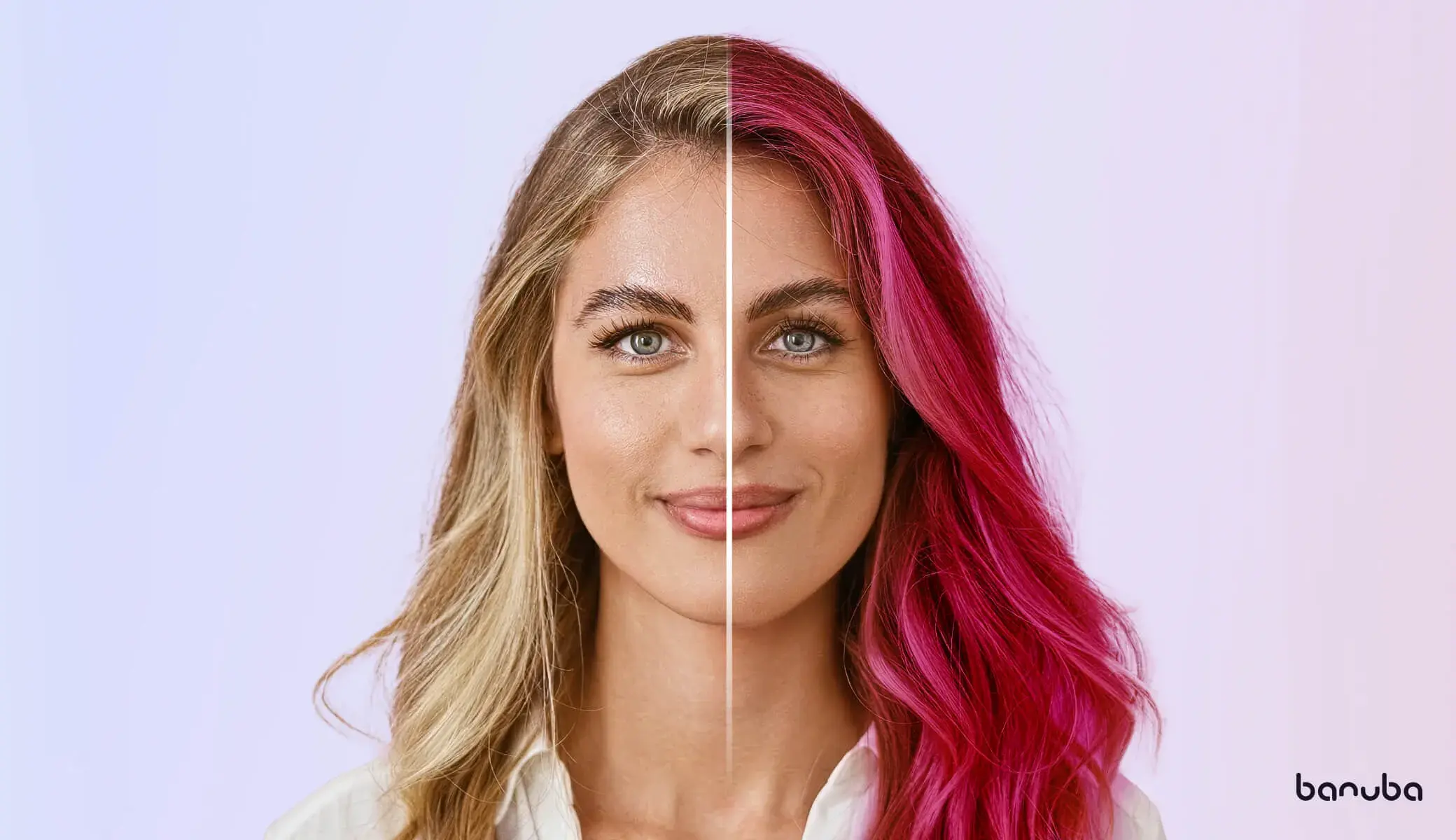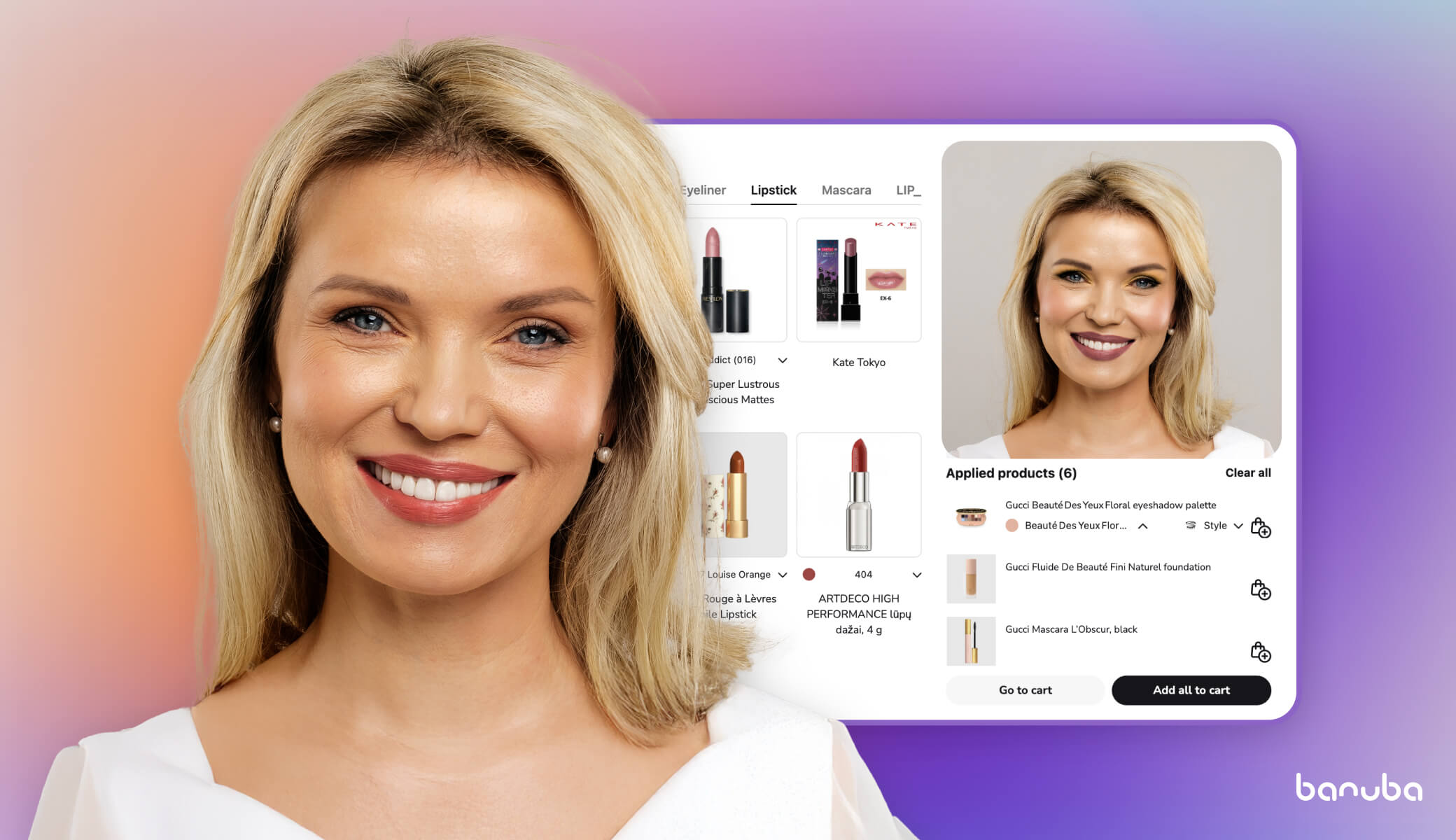[navigation]
TL;DR
- Virtual try-on (VTO) or augmented reality try-on uses augmented reality (AR), computer vision, and image processing to overlay digital versions of products onto images or videos of users. VTO helps online shoppers overcome uncertainties about fit, style, and appearance, similar to the experience in physical stores.
- AI analysis and recommendation systems can be integrated alongside with VTO to provide a personalized, interactive shopping journey, boosting customer engagement by at least 200%.
- VTO can be applied to various product categories, including clothing, accessories, footwear, hats, eyewear, jewelry, makeup, etc.
- The benefits of virtual try-on for business include the following:
- as customers have more confidence in their purchases, add-to-cart and sales rates increase dramatically (e.g. read how VTO increased add-to-cart rate over 600%)
- customers make more informed decisions, which cuts return rates by 64%
- as VTO reduces the need for physical samples, it contributing to a more sustainable business model
- as only 1% of retailers currently use the technology, AR-powered experiences bring businesses a serious competitive advantage
What Is Virtual Try-On?
Virtual try-on (VTO) technology allows customers to test products before purchasing, typically in an online or mobile shopping environment. However, brands like MAC and H&M also use virtual try-on in physical stores via smart mirrors and similar devices.
A VTO tool utilizes augmented reality (AR), computer vision, and image processing techniques to overlay digital representations of products onto videos, photos, or real-time images of the user. In essence, these copies are similar to 3D face masks like those in TikTok, Snapchat, and other apps. They are designed to attach to specific points on the face or body. In the case of cosmetics, the underlying neural networks also simulate the interaction between a product and the user’s skin.
Compared to other niches, the technology to try on clothes virtually is not as advanced. This is mostly because it is much more complicated:
- Different people have different body types, which makes it difficult to train the neural networks;
- Various designs and fabrics fit and behave differently from each other, and simulating interactions with light and gravity for them is challenging;
- Clothes try-on happens when people are already wearing something, and that clothing can distort the body shape;
- Processing the entire body in real time requires a lot of computing power – mobile devices can’t provide it.
There are various options for this (like smart mirrors or even Snapchat lens) but they only give a general idea of the look.
Benefits of Virtual Try-On for Shoppers
There are many reasons why 61% of customers prefer shops powered by the virtual try-on technology.
Firstly, it is available pretty much on any device with a camera and internet connection. This means shoppers can use it wherever they want, especially if they have a virtual try-on app on their mobile phone.
Secondly, when it comes to jewelry, cosmetics, accessories, or glasses the fit and looks are extremely realistic. The software simulates lighting and gravity interactions, and the modern algorithms ensure precise fit. The only thing missing is the ability to touch and feel the materials, otherwise it is very similar to the real thing. Seeing this, people become more confident in their purchases.
Thirdly, AR try-on lets people quickly switch between products and try multiple items at the same time. One can easily create entire looks and buy them without leaving the app.
Finally, it allows for a customized and personalized experience. Using in-app constructors, a shopper can modify the product (e.g. the elements of a hat or a pattern of a shawl) and immediately see how it would look.

Benefits of virtual try-on for businesses
The smart augmented reality partnered with machine learning hides more than revolutionary shopping opportunities and an attractive image for shoppers. Often, the impact of virtual fitting on business metrics and profitability increases exponentially. Let's explore what you can expect.
Enhanced Customer Experience
Virtual try-on technology offers customers an immersive and interactive shopping experience, diversifying the buyer journey with the try-before-you-buy feature from the comfort of their location. With advanced algorithms and machine learning, a VTO tool offers hyper-personalization and customization. According to statistics, AR boosts the engagement by 200%.
Higher Conversion Rates and Sales
By providing customers with the ability to virtually try on products, businesses can alleviate doubts and uncertainties associated with online shopping, leading to higher conversion rates. Shopify indicates a 94% growth. The confidence gained from trying on products virtually often translates into increased sales as customers are more likely to make a purchase.

Reduced Returns
Reducing return rates became one of the top priorities among mid and large US retailers in 2022. Buying makeup, glasses, or clothes online can turn into a blindfolded adventure with failed expectations resulting in high return rates. A virtual dressing room helps customers make more informed purchasing decisions and cut return rates by 64%.
Cost Savings and Sustainability
Implementing virtual try-on technology can lead to cost savings for businesses by reducing the need for physical samples, inventory holding costs, and showroom expenses. Additionally, these cutting-edge tools contribute to a more sustainable business model by minimizing waste and environmental impact associated with traditional retail practices.

Competitive Advantage
Businesses that adopt virtual try-on technology differentiate themselves from competitors by offering a cutting-edge and innovative shopping experience. Today, only 1% of retailers use AR in their business. By staying ahead of the curve and embracing emerging technologies, businesses can attract new online shoppers, retain existing ones, and position themselves as leaders in the industry.
Reach Wider Audience
Virtual try-on technology enables businesses to reach a wider audience by eliminating geographical barriers and time constraints associated with traditional in-store shopping. Customers can try on products anytime, anywhere, using their mobile devices or computers, resulting in a more convenient and accessible shopping experience.

Increased Brand Loyalty
By providing customers with a personalized and engaging shopping experience through virtual try-on technology, businesses can increase brand loyalty. Customers who have positive experiences with virtual try-ons are more likely to return to the brand for future purchases and recommend it to others, leading to long-term relationships and repeat business.

How Does Virtual Try-On Work?
Now let’s see how implementing virtual try-on solutions works from the business perspective. Suppose you have already selected the provider and are interested in the next steps.
Firstly, you need to integrate the chosen virtual try-on software. You can do it yourself, in which case the vendor will provide the documentation. Alternatively, most AR try-on providers offer integration assistance. Expect the process to take around 2 weeks.
Secondly, you need to create the 3D models of your products. There are three ways to do so:
- 3D scanning. A special device scans the physical product and creates a “vector point cloud” – its digital copy. It is very precise, but requires proper equipment.
- Photogrammetry. Using a few photos of the product, dedicated software creates its 3D model. The most common and cost-effective option.
- 3D modeling. A human designer manually creates a digital copy of the item.
In the case of makeup, the process is similar. Read the dedicated article to learn more about the nuances. Inquire about the conditions in advance: while every provider offers such services, the specific requirements and costs differ.

Banuba TINT virtual try-on SDK – the solution for your business
TINT, developed by Banuba, is more than just virtual try-on SDK. It is a full-fledged platform that helps online stores boost their business through the power of augmented reality. TINT supports many product types:
- Makeup
- Skincare
- Jewelry (necklaces, nose piercings, bracelets, watches, earrings, rings, etc.)
- Glasses/sunglasses
- Colored contacts
- Hair dyes
- Nail polish/Fake nails
- Headwear

It is one of the most realistic virtual try-on solutions on the market, boasting advanced simulations of light and gravity to ensure the digital products not only look, but also behave like the physical ones.
Besides the try-on, TINT boasts an AI makeup recommendations system. It automatically analyzes the face of the user, and suggests the most fitting products based on over 100 parameters (skin tone, hair color, face shape, etc.). The most suitable cosmetics get pushed to the front of the catalog to promote buying.
TINT has shown it can significantly boost business metrics. For example, Océane, a Brazilian cosmetics company, managed to achieve a 20.15% add-to-cart rate when the benchmark for the industry was just 3%. It can also boost sales by up to 300% and decrease the returns by up to 60%.
 Virtual nails try-on
Virtual nails try-on
The future of virtual try-on
The future of virtual try-on technology holds immense potential, particularly with advancements in body scanning and personalization. According to a report by Grand View Research, the global augmented reality market in retail is expected to reach $61.4 billion by 2023, growing at a compound annual growth rate (CAGR) of 48.0% from 2021. This growth is driven by the increasing demand for personalized shopping experiences and the need for retailers to differentiate themselves in a competitive market. Advanced body scanning technologies are becoming more accessible, enabling consumers to create accurate 3D models of their bodies. This allows for a more precise fitting experience, ultimately reducing return rates and increasing customer satisfaction.
The integration of artificial intelligence (AI) with virtual try-on solutions is enhancing personalization in ways previously unimaginable. AI algorithms can analyze user preferences, body types, and even past purchase behaviors to suggest the most suitable clothing options. A study by Shopify found that 67% of consumers expect personalized experiences from retailers, highlighting the importance of tailoring offerings to individual needs. As brands invest in these technologies, they can create immersive shopping experiences that not only engage customers but also foster loyalty and repeat business.
The retail industry is witnessing a significant shift towards the adoption of augmented reality, with many leading brands already implementing virtual try-on solutions. Companies like Sephora and Warby Parker have successfully integrated AR into their shopping experiences, allowing customers to virtually try on makeup or eyewear from the comfort of their homes. According to a report by McKinsey & Company, retailers that adopt AR technology can see a conversion rate increase of up to 40%. This statistic underscores the effectiveness of virtual try-on tools in enhancing consumer engagement and driving sales.
Conclusion
Virtual try-on can boost sales up to 300%, raise the add-to-cart rate up to 20.15%, and decrease product returns by up to 60%. This comes as a result of massively improved user experience: convenience, personalization, and confidence boost provided by VTO. TINT is on the cutting edge of this technology, supporting makeup, jewelry, glasses, hats, and many other products. Book a demo and see how it works for yourself.











 Virtual nails try-on
Virtual nails try-on

